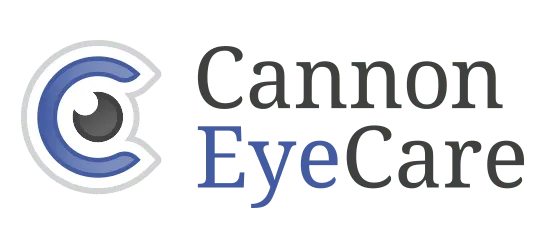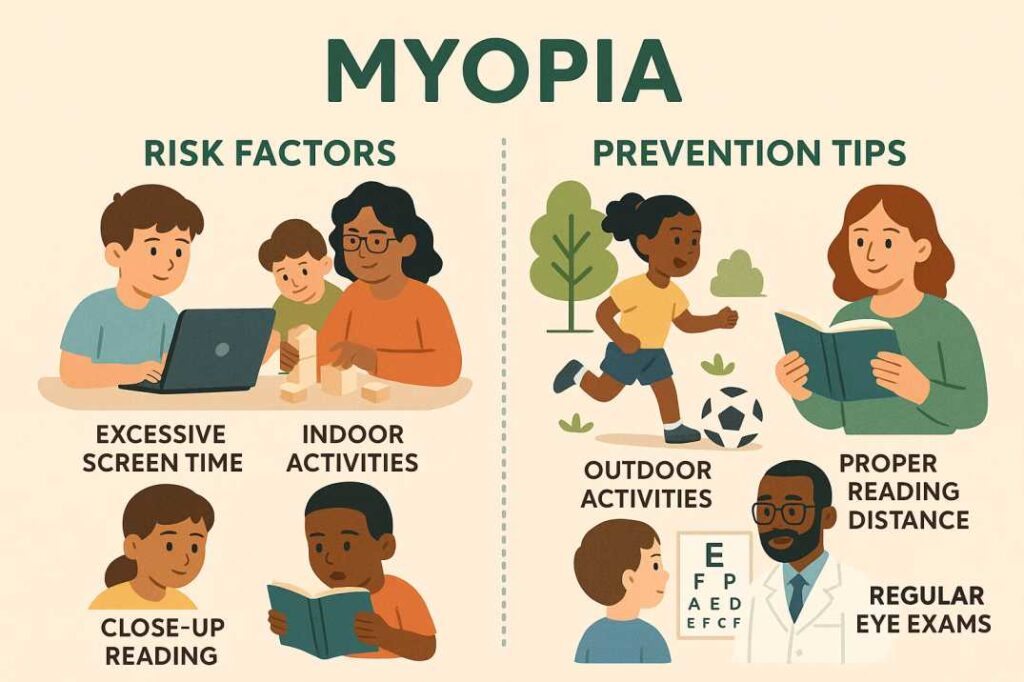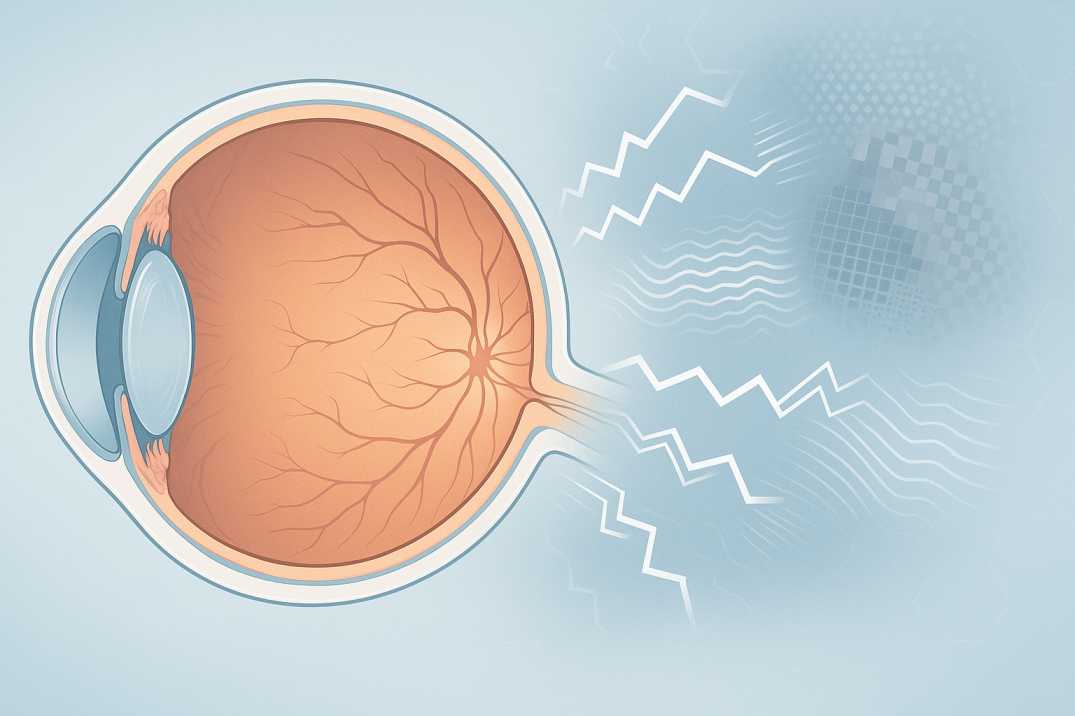Myopia (Nearsightedness)
Bottom Line Up Front: Myopia (nearsightedness) affects over 40% of Americans and is rapidly increasing among children. This comprehensive myopia guide covers everything you need to know about recognizing nearsightedness symptoms, understanding treatment options, and protecting your long-term eye health. Early detection and intervention are crucial for preventing myopia progression to high myopia, which can lead to serious eye complications later in life.
Myopia (nearsightedness), commonly known as nearsightedness, is a refractive error that makes distant objects appear blurry while close objects remain clear. This vision condition occurs when your eyeball grows too long from front to back, or when your cornea (the clear front layer of your eye) becomes too curved. These structural changes cause light entering your eye to focus in front of your retina instead of directly on it, resulting in blurred distance vision.
In simpler terms, if you have myopia (nearsightedness), you might struggle to read highway signs, see the whiteboard at school clearly, or recognize faces from across the room—but you can easily read a book or use your smartphone up close.
The Growing Myopia (Nearsightedness) Epidemic: Why This Matters More Than Ever
The numbers are staggering. In the early 1970s, only 25% of Americans were nearsighted. By 2004, that number had jumped to over 40%, and recent estimates suggest the current prevalence may be even higher at around 42% or more. Among children and adolescents globally, myopia prevalence has increased dramatically from 24.3% (2001-2010) to 29.7% (2011-2019) to 35.8% (2020-2023), with the most recent surge attributed partly to the COVID-19 pandemic and increased remote learning.
Research projects that by 2050, approximately 52% of the world’s population (close to 5 billion people) will be myopic, with about 10% experiencing high myopia. In some East Asian countries, myopia rates among teenagers already exceed 80-90%, with certain urban surveys in South Korea showing up to 96% of young adults are myopic.
What’s driving this myopia (nearsightedness) epidemic? Modern lifestyle factors play a significant role:
- Increased screen time and digital device usage
- More time spent indoors on “near work” activities like reading and homework
- Reduced outdoor play and natural light exposure
- Earlier introduction to digital devices in young children
Understanding the Science: How Myopia (Nearsightedness) Develops
The Normal Eye vs. The Myopic (Nearsighted) Eye
In a normally functioning eye, light enters through the cornea and lens, which work together to focus images precisely on the retina—the light-sensitive tissue at the back of your eye. The retina then converts these light signals into electrical impulses that your brain interprets as vision.
Nearsightedness happens when your eyeball grows too long from front to back, or when there are problems with the shape of your cornea (clear front layer of the eye) or lens (an inner part of the eye that helps the eye focus). In a myopic eye, these structural changes cause light to converge in front of the retina, creating that characteristic blurry distance vision.
Types of Myopia (Nearsightedness): Understanding the Spectrum
Low Myopia (Mild Nearsightedness)
- Requires less than 3 diopters of correction
- May only need glasses for specific activities like driving or watching movies
- Generally presents minimal health risks
Moderate Myopia (Nearsightedness)
- Requires 3-6 diopters of correction
- Typically needs corrective lenses throughout the day
- Increased risk of eye complications compared to low myopia
High Myopia (Severe Nearsightedness)
- Requires 6 or more diopters of correction
- Severe nearsightedness (which also qualifies as high myopia) requires 6 or more diopters for correction.
- Significantly elevated risk for serious eye conditions, including retinal detachment, glaucoma, and cataracts
Pathological (Degenerative) Myopia
- A rare, inherited form of myopia (nearsightedness) that continues progressing into adulthood
- Can lead to legal blindness
- Associated with severe structural changes in the eye
Recognizing Myopia (Nearsightedness) Symptoms: When to Seek Professional Care
Primary Myopia (Nearsightedness) Symptoms in Children and Adults
Distance Vision Problems:
- Difficulty seeing the classroom board, TV, or road signs clearly
- Squinting when trying to see distant objects
- Moving closer to see things better
- Complaints that distant objects appear blurry or “fuzzy”
Associated Symptoms:
- Frequent headaches, especially after activities requiring distance vision
- Eye strain and fatigue
- Difficulty driving, particularly at night
- Poor performance in sports requiring distance vision
- In children: declining school performance or shortened attention span
Red Flags That Require Immediate Attention
Contact an eye care professional promptly if you or your child experiences:
- Sudden changes in vision
- Severe eye pain or persistent headaches
- Flashing lights or “floaters” in your vision
- Any vision problems while wearing the current corrective lenses
Causes and Risk Factors: What Increases Your Myopia (Nearsightedness) Risk?
Genetic Factors
If you have myopia (nearsightedness), more than likely, at least one or both of your biological parents do, too. Research shows that children have:
- 3 times higher risk if one parent has myopia (nearsightedness)
- 6 times higher risk if both parents have myopia (nearsightedness)
However, genetics alone don’t determine whether you’ll develop myopia (nearsightedness)—environmental factors play an increasingly important role.
Environmental and Lifestyle Factors
Near Work Activities: Prolonged focus on close-up tasks strains your eyes’ focusing mechanism. This includes:
- Reading for extended periods
- Computer work and gaming
- Smartphone and tablet use
- Detailed crafts or hobbies
- Homework and studying
Reduced Outdoor Time: Children who spend more time outdoors are less likely to be nearsighted, but experts aren’t sure why. Current recommendations suggest children spend 90-120 minutes outdoors daily to help prevent myopia onset.
Age and Developmental Factors:
- Most commonly develops between ages 6 and 14
- Typically progresses during the school years
- Usually stabilizes by the early twenties, though some cases continue progressing into the thirties
Treatment Options: From Basic Correction to Advanced Management
Traditional Correction Methods
Prescription Eyeglasses:
- Most common and accessible treatment option
- Concave lenses help redirect light to focus properly on the retina
- May only be needed for specific activities in mild cases
- Required full-time for moderate to severe myopia
- Annual costs range from $150-$1,000, depending on lens type and usage
- Daily disposables: $400-$1,000+ per year if worn daily
- Monthly lenses: $200-$400 per year plus cleaning solutions
- Require proper hygiene and care protocols
- May offer better vision quality for some patients than glasses
Advanced Treatment Options
Refractive Surgery: For adults with stable prescriptions, surgical options include:
LASIK (Laser-Assisted In Situ Keratomileusis):
- Most popular refractive surgery with costs ranging from $1,500-$5,000 per eye
- National average around $2,000-$3,000 per eye for modern all-laser procedures
- Quick recovery time with minimal discomfort
- High success rates with 98-99% of patients achieving 20/20 vision or better at top-tier providers
PRK (Photorefractive Keratectomy):
- Alternative for patients not suitable for LASIK
- Removes surface corneal tissue to reshape the eye
- Longer recovery period but similar long-term results
Implantable Lenses:
- Option for very high myopia cases
- An artificial lens is placed inside the eye
- Reversible procedure, unlike laser surgery
Myopia Management: Slowing Progression in Children
Orthokeratology (Ortho-K):
- Initial fitting costs $600-$1,200 per eye (complex cases up to $2,000+ per eye)
- Annual replacement costs around $650, including follow-up visits
- Special rigid contact lenses are worn overnight
- Temporarily reshape the cornea while sleeping
- Provides clear daytime vision without corrective lenses
Multifocal Contact Lenses:
- MiSight 1-day lenses are FDA-approved for myopia control
- MiSight is the first and only FDA-approved contact lens to slow myopia progression in children
- Special optical design helps slow eye elongation
- Available for children as young as 8 years old
Atropine Eye Drops:
- Low-dose (0.01%) atropine shows 30-60% efficacy in slowing progression
- Research suggests roughly 80% of children experience slowed myopia progression
- Applied nightly before bedtime with minimal side effects at low concentrations
- Often combined with other treatments for optimal results
Potential Complications: Why Managing Myopia Matters
High myopia significantly increases your risk for serious eye conditions later in life:
Retinal Complications
- Retinal Detachment: Higher risk due to elongated eyeball structure
- Myopic Maculopathy: Damage to the central vision area
- Retinal Tears: Increased vulnerability in stretched retinal tissue
Glaucoma
This group of various eye diseases is caused by increased pressure within the eye that can lead to loss of vision. Glaucoma is a leading cause of vision loss among those over age 60. Myopic individuals have 2-3 times higher risk.
Cataracts
Studies have found that those who have had severe myopia that occurs before age 20 are at a higher risk of developing cataracts. The clouding of the eye’s natural lens can occur earlier in myopic eyes.
Economic Impact
The lifetime cost of corrective lenses for myopia can be substantial. Contact lenses alone can cost $150-$1,000 per year, depending on type (daily disposables vs. monthly) and usage patterns. Over decades, contact lens wearers may pay upwards of $30,000 for vision correction, excluding potential complications. When combined with glasses, exam costs, and treatment for complications, the total lifetime cost for myopia correction can be significant.
Prevention Strategies: Protecting Your Family’s Vision
For Children and Teens
Screen Time Management:
- Follow the 20-20-20 rule: Every 20 minutes, look at something 20 feet away for 20 seconds
- Limit recreational screen time to under 3 hours daily
- Maintain proper viewing distance (arm’s length for computers)
- Ensure adequate lighting when using devices
Outdoor Activity:
- Encourage at least 90 minutes of outdoor time daily
- Natural light exposure appears protective against myopia development
- Outdoor activities don’t need to be sports-related—any time outside helps
Proper Reading Habits:
- Maintain appropriate reading distance (about 16 inches)
- Take regular breaks during homework or reading sessions
- Ensure adequate lighting for all near-work activities
For Adults
Workplace Eye Health:
- Adjust the computer screen height to slightly below eye level
- Use anti-glare filters or blue light filtering glasses
- Take regular breaks from computer work
- Ensure proper workplace lighting
Regular Eye Examinations:
- Annual comprehensive eye exams for myopic individuals
- Monitor for changes in prescription or eye health
- Early detection of complications allows for prompt treatment
When to Seek Professional Care
For Children
Schedule an eye examination if your child:
- Shows signs of struggling to see distant objects
- Complaints of headaches or eye strain
- Has declining school performance
- Fails a vision screening
- Has myopic parents (higher risk)
For Adults
See an eye care professional if you experience:
- Changes in your vision quality
- Increased difficulty with distance vision
- New onset of headaches or eye strain
- Any sudden vision changes or symptoms
The Role of Comprehensive Eye Care
A thorough eye examination goes beyond simply determining your glasses prescription. At Cannon EyeCare, our comprehensive approach includes:
Advanced Diagnostic Testing:
- Digital retinal photography to monitor eye health over time
- Corneal mapping for contact lens fitting and surgical planning
- Intraocular pressure measurement for glaucoma screening
- Detailed assessment of eye muscle function and coordination
Personalized Treatment Planning: Our experienced team takes time to understand your individual needs, lifestyle, and vision goals. We explain all treatment options clearly and help you make informed decisions about your eye care.
Ongoing Monitoring: Myopia management requires regular follow-up care to track progression and adjust treatments as needed. We provide detailed tracking and communication throughout your care journey.
Looking Ahead: The Future of Myopia Care
Research continues to advance our understanding of myopia development and treatment options. Emerging therapies show promise for even better control of myopia progression, and new technologies are making treatment more convenient and effective.
Recent Research Highlights:
- Outdoor Light Therapy: Studies investigating the role of specific light wavelengths in myopia prevention
- Pharmaceutical Approaches: Development of new eye drop formulations with improved efficacy
- Advanced Lens Designs: Next-generation contact lenses and glasses with enhanced myopia control properties
Scientific References and Resources
The information in this comprehensive myopia guide is supported by current scientific research and authoritative medical sources. Below are three key studies and resources that informed this article:
1. Global Prevalence and Temporal Trends Study (2025)
Source: Vision Center – Myopia Statistics, Trends, Causes, & Solutions
This landmark 2025 analysis provides current global myopia prevalence data, showing rates rising from 25% in the 1970s to over 40% by 2004 in the United States, with projections indicating approximately half of the global population (close to 5 billion people) will be myopic by 2050. The study emphasizes the urgent need for preventive measures and myopia management strategies.
2. Myopia Control Treatment Efficacy Research
Source: Seattle Eye Associates – Myopia Control Clinic Research
Clinical research demonstrates that low-dose atropine eye drops show 30-60% efficacy in slowing myopia progression in children, while specialized contact lenses (multifocal contacts, orthokeratology) similarly reduce progression rates by 40-60% on average. This research supports evidence-based myopia management approaches currently available to patients.
3. Economic Impact and Visual Impairment Projections
Source: Scientific Reports – Myopia Visual Impairment Study (2023)
Recent projections indicate that between 27% and 43% of uncorrectable visual impairment in the US population by 2050 will be directly attributable to myopia complications, highlighting the critical importance of early intervention and proper myopia management. This underscores why managing myopia progression is essential for long-term eye health.
Additional Authoritative Resources:
- National Eye Institute – Nearsightedness (Myopia)
- American Academy of Ophthalmology – Myopia (Nearsightedness)
- Cleveland Clinic – Myopia (Nearsightedness) Overview
- Myopia Institute – Global Myopia Research
These citations represent peer-reviewed research and clinical studies that support the treatment recommendations and statistical data presented in this guide. For complete references and additional research, consult with your eye care professional.
Taking Action: Your Next Steps
If you suspect myopia in yourself or your child:
- Schedule a comprehensive eye examination with a qualified eye care professional
- Discuss family history and lifestyle factors during your appointment
- Ask about myopia management options if myopia is diagnosed, especially for children
- Implement preventive strategies regardless of current vision status
- Plan for regular follow-up care to monitor vision health over time
Schedule Your Eye Care Consultation
If you’re experiencing vision changes or have concerns about myopia, professional eye care is essential. Regular comprehensive eye examinations can detect myopia early and help prevent complications through appropriate management strategies.
When to Schedule an Appointment:
- Annual comprehensive eye exams for all ages
- Immediate evaluation for sudden vision changes
- Children showing signs of vision difficulties
- Adults experiencing eye strain or headaches
- Anyone with a family history of eye conditions
What to Expect During Your Visit:
- Comprehensive vision and eye health assessment
- Discussion of symptoms and family history
- Explanation of treatment options if myopia is detected
- Personalized recommendations for your specific needs
- Follow-up care planning for ongoing monitoring
Remember that early detection and intervention are key to successful myopia management and long-term eye health protection.
Conclusion: Protecting Your Vision for Life
Myopia is more than just an inconvenience requiring glasses or contacts—it’s a progressive condition that can significantly impact your long-term eye health and quality of life. Understanding the causes, recognizing symptoms early, and taking proactive steps toward management and prevention are crucial for maintaining healthy vision throughout your lifetime.
The encouraging news is that we have more tools than ever before to effectively manage myopia and slow its progression, especially when caught early. Whether you’re dealing with your own vision changes or concerned about your child’s development, professional eye care provides the expertise and treatment options needed to protect your vision for years to come.
Don’t wait for vision problems to interfere with your daily life. Take action today by scheduling a comprehensive eye examination and discussing the best approach for your individual needs. Your future self will thank you for investing in your vision health now.
This article is for educational purposes only and does not replace professional medical advice. Always consult with a qualified eye care professional for personalized diagnosis and treatment recommendations.
FAQs
-
Myopia is when distant objects appear blurry while close objects remain clear due to the eyeball growing too long. Common signs include squinting to see far away, difficulty reading street signs, and headaches from eye strain.




